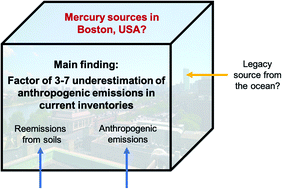Atmospheric mercury sources in a coastal-urban environment: a case study in Boston, Massachusetts, USA†
Abstract
Mercury (Hg) is an environmental toxicant dangerous to human health and the environment. Its anthropogenic emissions are regulated by global, regional, and local policies. Here, we investigate Hg sources in the coastal city of Boston, the third largest metropolitan area in the Northeastern United States. With a median of 1.37 ng m−3, atmospheric Hg concentrations measured from August 2017 to April 2019 were at the low end of the range reported in the Northern Hemisphere and in the range reported at North American rural sites. Despite relatively low ambient Hg concentrations, we estimate anthropogenic emissions to be 3–7 times higher than in current emission inventories using a measurement-model framework, suggesting an underestimation of small point and/or nonpoint emissions. We also test the hypothesis that a legacy Hg source from the ocean contributes to atmospheric Hg concentrations in the study area; legacy emissions (recycling of previously deposited Hg) account for ∼60% of Hg emitted annually worldwide (and much of this recycling takes place through the oceans). We find that elevated concentrations observed during easterly oceanic winds can be fully explained by low wind speeds and recirculating air allowing for accumulation of land-based emissions. This study suggests that the influence of nonpoint land-based emissions may be comparable in size to point sources in some regions and highlights the benefits of further top-down studies in other areas.

- This article is part of the themed collections: Environmental Science: Processes & Impacts Recent HOT Articles and Atmospheric chemistry


 Please wait while we load your content...
Please wait while we load your content...